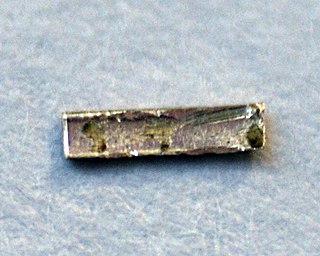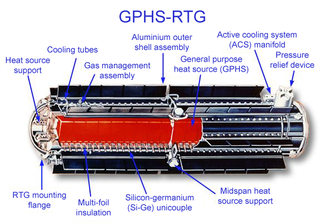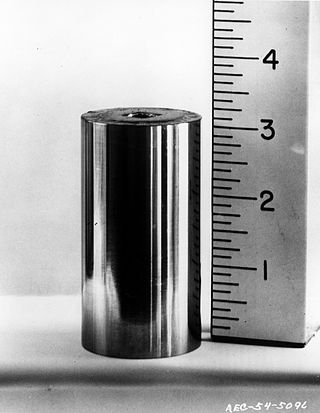Related Research Articles
Background radiation is a measure of the level of ionizing radiation present in the environment at a particular location which is not due to deliberate introduction of radiation sources.

The hertz is the unit of frequency in the International System of Units (SI), equivalent to one event per second. The hertz is an SI derived unit whose expression in terms of SI base units is s−1, meaning that one hertz is the reciprocal of one second. It is named after Heinrich Rudolf Hertz (1857–1894), the first person to provide conclusive proof of the existence of electromagnetic waves. Hertz are commonly expressed in multiples: kilohertz (kHz), megahertz (MHz), gigahertz (GHz), terahertz (THz).

In physics, radiation is the emission or transmission of energy in the form of waves or particles through space or a material medium. This includes:

The second is the unit of time in the International System of Units (SI), historically defined as 1⁄86400 of a day – this factor derived from the division of the day first into 24 hours, then to 60 minutes and finally to 60 seconds each. "Minute" comes from the Latin pars minuta prima, meaning "first small part", and "second" comes from the pars minuta secunda, "second small part".

Strontium is a chemical element; it has symbol Sr and atomic number 38. An alkaline earth metal, strontium is a soft silver-white yellowish metallic element that is highly chemically reactive. The metal forms a dark oxide layer when it is exposed to air. Strontium has physical and chemical properties similar to those of its two vertical neighbors in the periodic table, calcium and barium. It occurs naturally mainly in the minerals celestine and strontianite, and is mostly mined from these.

The alkaline earth metals are six chemical elements in group 2 of the periodic table. They are beryllium (Be), magnesium (Mg), calcium (Ca), strontium (Sr), barium (Ba), and radium (Ra). The elements have very similar properties: they are all shiny, silvery-white, somewhat reactive metals at standard temperature and pressure.

Nuclear fallout is the residual radioactive material propelled into the upper atmosphere following a nuclear blast, so called because it "falls out" of the sky after the explosion and the shock wave has passed. It commonly refers to the radioactive dust and ash created when a nuclear weapon explodes. The amount and spread of fallout is a product of the size of the weapon and the altitude at which it is detonated. Fallout may get entrained with the products of a pyrocumulus cloud and fall as black rain. This radioactive dust, usually consisting of fission products mixed with bystanding atoms that are neutron-activated by exposure, is a form of radioactive contamination.

The decay energy is the energy change of a nucleus having undergone a radioactive decay. Radioactive decay is the process in which an unstable atomic nucleus loses energy by emitting ionizing particles and radiation. This decay, or loss of energy, results in an atom of one type transforming to an atom of a different type.

The curie is a non-SI unit of radioactivity originally defined in 1910. According to a notice in Nature at the time, it was to be named in honour of Pierre Curie, but was considered at least by some to be in honour of Marie Curie as well, and is in later literature considered to be named for both.
Ionizing radiation (US) (or ionising radiation [UK]), including nuclear radiation, consists of subatomic particles or electromagnetic waves that have sufficient energy to ionize atoms or molecules by detaching electrons from them. Some particles can travel up to 99% of the speed of light, and the electromagnetic waves are on the high-energy portion of the electromagnetic spectrum.

A radioisotope thermoelectric generator, sometimes referred to as a radioisotope power system (RPS), is a type of nuclear battery that uses an array of thermocouples to convert the heat released by the decay of a suitable radioactive material into electricity by the Seebeck effect. This type of generator has no moving parts and is ideal for deployment in remote and harsh environments for extended periods with no risk of parts wearing out or malfunctioning.

Dual-energy X-ray absorptiometry is a means of measuring bone mineral density (BMD) using spectral imaging. Two X-ray beams, with different energy levels, are aimed at the patient's bones. When soft tissue absorption is subtracted out, the bone mineral density (BMD) can be determined from the absorption of each beam by bone. Dual-energy X-ray absorptiometry is the most widely used and most thoroughly studied bone density measurement technology.

Nuclear fission products are the atomic fragments left after a large atomic nucleus undergoes nuclear fission. Typically, a large nucleus like that of uranium fissions by splitting into two smaller nuclei, along with a few neutrons, the release of heat energy, and gamma rays. The two smaller nuclei are the fission products..

Caesium-137, cesium-137 (US), or radiocaesium, is a radioactive isotope of caesium that is formed as one of the more common fission products by the nuclear fission of uranium-235 and other fissionable isotopes in nuclear reactors and nuclear weapons. Trace quantities also originate from spontaneous fission of uranium-238. It is among the most problematic of the short-to-medium-lifetime fission products. Caesium-137 has a relatively low boiling point of 671 °C (1,240 °F) and easily becomes volatile when released suddenly at high temperature, as in the case of the Chernobyl nuclear accident and with atomic explosions, and can travel very long distances in the air. After being deposited onto the soil as radioactive fallout, it moves and spreads easily in the environment because of the high water solubility of caesium's most common chemical compounds, which are salts. Caesium-137 was discovered by Glenn T. Seaborg and Margaret Melhase.

Strontium-90 is a radioactive isotope of strontium produced by nuclear fission, with a half-life of 28.8 years. It undergoes β− decay into yttrium-90, with a decay energy of 0.546 MeV. Strontium-90 has applications in medicine and industry and is an isotope of concern in fallout from nuclear weapons, nuclear weapons testing, and nuclear accidents.
Naturally occurring radioactive materials (NORM) and technologically enhanced naturally occurring radioactive materials (TENORM) consist of materials, usually industrial wastes or by-products enriched with radioactive elements found in the environment, such as uranium, thorium and potassium and any of their decay products, such as radium and radon. Produced water discharges and spills are a good example of entering NORMs into the surrounding environment.
Project GABRIEL was an investigation to gauge the impact of nuclear fallout resulting from nuclear warfare. The United States Atomic Energy Commission surmised that the radioactive isotope strontium-90 (Sr-90) presented the greatest hazard to life globally, which resulted in the commissioning of Project SUNSHINE: which sought to examine the levels of Sr-90 in human tissues and bones gathered from around the world.
Project SUNSHINE was a series of research studies that began in 1953 to ascertain the impact of radioactive fallout on the world's population. The project was initially kept secret, and only became known publicly in 1956. Commissioned jointly by the United States Atomic Energy Commission and USAF Project Rand, SUNSHINE sought to examine the long-term effects of nuclear radiation on the biosphere due to repeated nuclear detonations of increasing yield. With the conclusion from Project GABRIEL that radioactive isotope Sr-90 represented the most serious threat to human health from nuclear fallout, Project SUNSHINE sought to measure the global dispersion of Sr-90 by measuring its concentration in the tissues and bones of the dead. Of particular interest was tissue from the young, whose developing bones have the highest propensity to accumulate Sr-90 and thus the highest susceptibility to radiation damage. SUNSHINE elicited a great deal of controversy when it was revealed that many of the remains sampled were utilized without prior permission from relatives of the dead, which wasn't known until many years later.
The Baby Tooth Survey was initiated by the Greater St. Louis Citizens' Committee for Nuclear Information in conjunction with Saint Louis University and the Washington University School of Dental Medicine as a means of determining the effects of nuclear fallout in the human anatomy by examining the levels of radioactive material absorbed into the deciduous teeth of children.

Charles Pecher was a Belgian pioneer in nuclear medicine. He discovered and introduced strontium-89 in medical therapeutic procedures in 1939.
References
- ↑ "Doctor Warns of Atom War Results". Meriden Journal, via Google News. 3 June 1957. Retrieved 23 July 2012.
- ↑ "Electromagnetic Radiation Effects Addressed by Canadian Hospital". IVN.us. 24 June 2012. Retrieved 23 July 2012.
- ↑ "Project Pluto". Archived from the original on 29 March 2020. Retrieved 23 July 2012.
- ↑ "Atoms for Peace and War, 1953-1961: Eisenhower and the Atomic Energy Commission. Berkeley". The SHAFR Guide Online: 329. doi:10.1163/2468-1733_shafr_sim140110016 . Retrieved 2023-11-19.